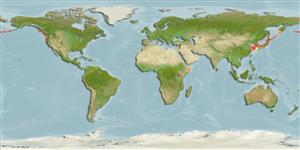Environment: milieu / climate zone / depth range / distribution range
Οικολογία
Θαλασσινό(ά) βενθικό(ς); ωκεανόδρομο(ς) (Ref. 51243); εύρος βάθους 0 - 172 m (Ref. 114018). Temperate; 54°N - 30°N, 118°E - 118°W
Northwest Pacific: inland Sea of Japan to Kyushu, Japan. Northeast Pacific: From southern California to the western Aleutian Islands (Ref. 114018), Alaska (Ref. 11366).
Μέγεθος / Βάρος / Age
Maturity: Lm ? range ? - ? cm
Max length : 15.0 cm SL αρσενικό/απροσδιόριστο; (Ref. 559); common length : 10.0 cm SL αρσενικό/απροσδιόριστο; (Ref. 559); μεγ. δημοσιευμένο βάρος: 10.60 g (Ref. 112063); μεγ. αναφερόμενη ηλικία: 3.00 έτη (Ref. 125612)
Ραχιαίες άκανθες (συνολικά): 0; Μαλακές ραχιαίες ακτίνες (συνολικά): 55-59; Εδρικές άκανθες 0; Μαλακές εδρικές ακτίνες: 28 - 32; Σπόνδυλοι: 62 - 67. Characterized by having a horizontal skin fold along its ventral contour, and the absence of pelvic fin and teeth. Lateral plicae 160 to 180. Lower jaw pointed. Lateral line system on head not continuous with that on the body.
Found in sand bottoms and may enter semi-enclosed sea areas (Ref. 11230). Forms large schools. Important food fish in Japan (marketed fresh or dried) and marketed fresh but mainly used for meal and oil manufacture in Europe (Ref. 10384). Common size taken from picture in Ref. 559. Maximum size estimated as 1.5 * common size. Two genetically different lineages were found in Japan Sea/East Sea, perhaps representing two different species (J.K. Kim, oral.comm, FishBoL2012, June 2012).
Life cycle and mating behavior
Γεννητική Ωρίμανση | Αναπαραγωγή | Γεννοβολία | Αβγά | Γονιμότητα | Προνύμφες
Masuda, H., K. Amaoka, C. Araga, T. Uyeno and T. Yoshino, 1984. The fishes of the Japanese Archipelago. Vol. 1. Tokai University Press, Tokyo, Japan. 437 p. (text). (Ref. 559)
IUCN Red List Status (Ref. 130435)
Threat to humans
Harmless
Human uses
αλιεία: πολύ εμπορικό
Περισσότερες πληροφορίες
ΑναφορέςΥδατοκαλλιέργειεςΠροφίλ υδατοκαλλιέργειαςΣτελέχοιΓενετικήElectrophoresesΚληρονομικότηταΑσθένειεςΜεταποίησηNutrientsMass conversion
ΣυνεργάτεςΦωτογραφίεςStamps, Coins Misc.ΉχοιΣιγκουατέραΤαχύτηταΚολυμβητικός ΤύποςΕπιφάνεια βραγχίωνOtolithsΕγκέφαλοιΌραση
Εργαλεία
Special reports
Download XML
Διαδικτυακές πηγές
Estimates based on models
Preferred temperature (Ref.
123201): 11.9 - 23, mean 19.1 °C (based on 74 cells).
Phylogenetic diversity index (Ref.
82804): PD
50 = 0.5156 [Uniqueness, from 0.5 = low to 2.0 = high].
Bayesian length-weight: a=0.01000 (0.00524 - 0.01907), b=3.23 (3.06 - 3.40), in cm total length, based on LWR estimates for this species & Genus-body shape (Ref.
93245).
Τροφικό Επίπεδο (Ref.
69278): 3.1 ±0.1 se; based on size and trophs of closest relatives
Generation time: 1.1 ( na - na) years. Estimated as median ln(3)/K based on 1
growth studies.
Ελαστικότητα (Ref.
120179): Υψηλό, ελάχιστος χρόνος για διπλασιασμό πληθυσμού < 15 μήνες (K=0.6).
Prior r = 0.79, 95% CL = 0.52 - 1.18, Based on 4 stock assessments.
Fishing Vulnerability (Ref.
59153): Low vulnerability (14 of 100).
Climate Vulnerability (Ref.
125649): Low vulnerability (17 of 100).
Nutrients (Ref.
124155): Calcium = 86.7 [47.1, 189.0] mg/100g; Iron = 0.509 [0.278, 0.951] mg/100g; Protein = 18.8 [17.3, 20.2] %; Omega3 = 0.467 [0.238, 0.873] g/100g; Selenium = 12.6 [5.7, 28.3] μg/100g; VitaminA = 31.4 [7.8, 121.8] μg/100g; Zinc = 0.773 [0.521, 1.136] mg/100g (wet weight);
